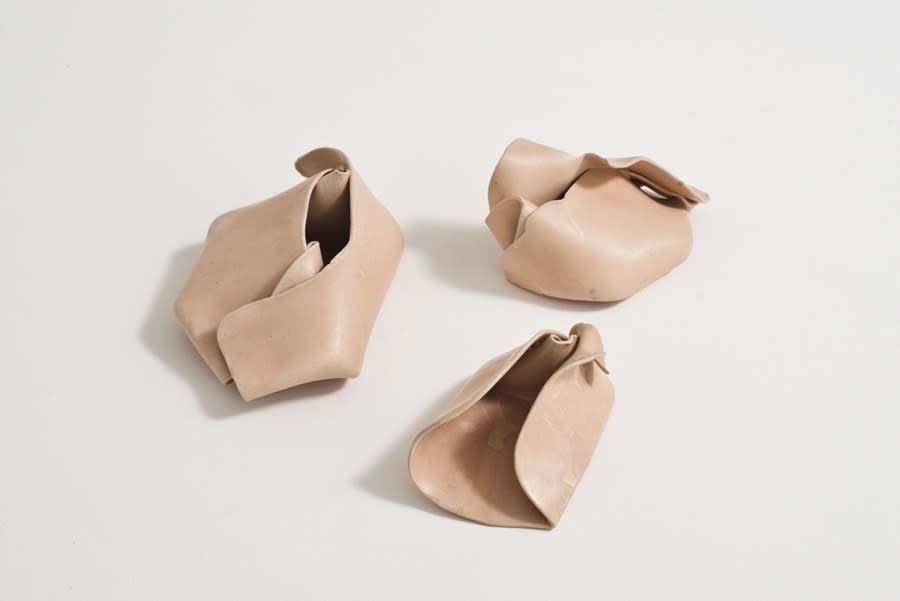


Hannah Wilke
Untitled, 1977
Unglazed ceramic
3 elements (from left to right):
i) 6.5 x 16.3 x 9.2 cm, 2 1/2 x 6 3/8 x 3 5/8 in
ii) 5.5 x 10.5 x 7 cm, 2 1/8 x 4 1/8 x 2 3/4 in
iii) 6 x 12.5 x 8 cm, 2 3/8 x 4 7/8 x 3 1/8 in
i) 6.5 x 16.3 x 9.2 cm, 2 1/2 x 6 3/8 x 3 5/8 in
ii) 5.5 x 10.5 x 7 cm, 2 1/8 x 4 1/8 x 2 3/4 in
iii) 6 x 12.5 x 8 cm, 2 3/8 x 4 7/8 x 3 1/8 in
© Marsie, Emanuelle, Damon and Andrew Scharlatt, Hannah Wilke Collection & Archive, Los Angeles. Licensed by VAGA at Artist’s Rights Society (ARS), New York, DACs, London
Further images
Hannah Wilke (1940-1993) started making the “vulval” shapes, “one-fold gestural sculptures,” as she called them, in clay in the early 1960s. Though they were clearly erotically charged, she always intended...
Hannah Wilke (1940-1993) started making the “vulval” shapes, “one-fold gestural sculptures,” as she called them, in clay in the early 1960s. Though they were clearly erotically charged, she always intended for the shapes to conjure a host of other material associations.
'My folded clay pieces are like little pieces of nature, a new species. They exist the way sea shells exist....' Hannah Wilke, quoted in 1998.
This is an early example of her work in unglazed clay, a material she used to powerful effect throughout the 1970s. During this period, she was interested in radical engagement with form, feminism, and materiality. Wilke hand-shaped these intimate, folded sculptures at a time when she was challenging dominant narratives around the female body in art. Often misunderstood in their time, these pieces are now recognised as vital contributions to post-minimalist and feminist discourse. Their immediacy and tactility reflect Wilke’s belief in the power of gesture and vulnerability as political acts.
Over the last decade, major museums have acknowledged Wilke’s previously overlooked importance through significant acquisitions: MoMA, New York; Solomon R. Guggenheim, New York; Whitney Museum of American Art, New York; LACMA, Los Angeles; and Centre Pompidou, Paris. Tate, London, recently acquired Wilke’s iconic installation 'Elective Affinities' (1978), consisting of 76 glazed porcelain white sculptures laid out in grid-like formats.
'My folded clay pieces are like little pieces of nature, a new species. They exist the way sea shells exist....' Hannah Wilke, quoted in 1998.
This is an early example of her work in unglazed clay, a material she used to powerful effect throughout the 1970s. During this period, she was interested in radical engagement with form, feminism, and materiality. Wilke hand-shaped these intimate, folded sculptures at a time when she was challenging dominant narratives around the female body in art. Often misunderstood in their time, these pieces are now recognised as vital contributions to post-minimalist and feminist discourse. Their immediacy and tactility reflect Wilke’s belief in the power of gesture and vulnerability as political acts.
Over the last decade, major museums have acknowledged Wilke’s previously overlooked importance through significant acquisitions: MoMA, New York; Solomon R. Guggenheim, New York; Whitney Museum of American Art, New York; LACMA, Los Angeles; and Centre Pompidou, Paris. Tate, London, recently acquired Wilke’s iconic installation 'Elective Affinities' (1978), consisting of 76 glazed porcelain white sculptures laid out in grid-like formats.
Provenance
The ArtistMarsie, Emanuelle, Damon, and Andrew Scharlatt, by descent
Hannah Wilke Collection & Archive, Los Angeles


